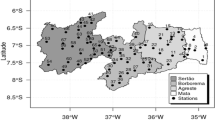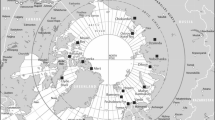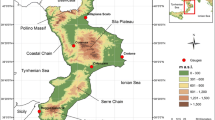Abstract
In this paper, we have analyzed the time series of daily values for three meteorological elements, two continuous and a discontinuous one, i.e., the maximum and minimum air temperature and the precipitation. The analysis was done based on the observations from seven stations in Serbia from the period 1951–2010. The main aim of this paper was to quantify the complexity of the annual values for the mentioned time series and to calculate the rate of its change. For that purpose, we have used the sample entropy and the Kolmogorov complexity as the measures which can indicate the variability and irregularity of a given time series. Results obtained show that the maximum temperature has increasing trends in the given period which points out a warming, ranged in the interval 1–2 °C. The increasing temperature indicates the higher internal energy of the atmosphere, changing the weather patterns, manifested in the time series. The Kolmogorov complexity of the maximum temperature time series has statistically significant increasing trends, while the sample entropy has increasing but statistically insignificant trend. The trends of complexity measures for the minimum temperature depend on the location. Both complexity measures for the precipitation time series have decreasing trends.



Similar content being viewed by others
References
Bajat B, Blagojević D, Kilibarda M, Luković J, Tošić I (2014) Spatial analysis of the temperature trends in Serbia during the period 1961–2010. Theor Appl Climatol (online). doi:10.1007/s00704-014-1243-7
Balzter H, Tate NJ, Kaduk J, Harper D, Page S, Morrison R, Muskulus M, Jones P (2015) Multi-scale entropy analysis as a method for time-series analysis of climate data. Climate 3(1):227–240
Gocić M, Trajković S (2014) Spatio-temporal patterns of precipitation in Serbia. Theor Appl Climatol 117:419–431. doi:10.1007/s00704-013-1017-7
http://www.ipcc.ch/pdf/assessment-report/ar5/wg1/WG1AR5_Chapter02_FINAL.pdf. Accessed 16 Apr 2015
Hu J, Gao J, Principe JC (2006) Analysis of biomedical signals by the Lempel-Ziv complexity: the effect of finite data size. IEEE T Bio-Eng 53:2606–2609
IPCC (2012) Managing the risks of extreme events and disasters to advance climate change adaptation. In: Field CB, Barros V, Stocker TF, Qin D, Dokken DJ, Ebi KL, Mastrandrea MD, Mach KJ, Plattner G-K, Allen SK, Tignor M, Midgley PM (eds) A special report of working Groups I and II of the Intergovernmental Panel on Climate Change. Cambridge University Press, Cambridge, p 582
Kendall MG (1975) Rank correlation methods, 4th edn. Charles Griffin, London, 196 pp
Kottek M, Grieser J, Beck C, Rudolf B, Rubel F (2006) World map of the Köppen–Geiger climate classification updated. Meteorol Z 15:259–263
Lakatos M, Szentimrey T, Bihari Z, Szalai S (2013) Creation of a homogenized climate database for the Carpathian region by applying the MASH procedure and the preliminary analysis of the data. Időjárás 117(1):143–158
Lake DE, Richman JS, Griffin MP, Moorman JR (2002) Sample entropy analysis of neonatal heart rate variability. Am J Physiol Heart C 283:R789
Lalić B, Eitzinger J, Mihailović DT, Thaler S, Jančić M (2013) Climate change impacts on winter wheat yield change—which climatic parameters are crucial in Pannonian lowland? J Agr Sci 151(06):757–774
Lempel A, Ziv J (1976) On the complexity of finite sequences. IEEE Trans Inform Theory 22:75–81
Li M, Vitanyi P (1997) An introduction to Kolmogorov complexity and its applications, 2nd edn. Springer Verlag, Berlin, p 188
Li S, Zhou Q, Wu S, Dai E (2006) Measurement of climate complexity using sample entropy. Int J Clim 26:2131–2139
Lorenz EN (1982) Atmospheric predictability experiments with a large numerical model. Tellus 34:505–513
Malinović-Miličević S, Radovanović MM, Stanojević G, Milovanović B (2015) Recent changes in Serbian climate extreme indices from 1961 to 2010. Theor Appl Climatol (First online: 05 May 2015). doi:10.1007/s00704-015-1491-1
Mann HB (1945) Non-parametric tests against trend. Econometrica 13:245–259
Mihailović DT, Nikolić-Đorić E, Drešković N, Mimić G (2014) Complexity analysis of the turbulent environmental fluid flow time series. Physica A 395:96–104
Mihailović DT, Lalić B, Drešković N, Mimić G, Djurdjević V, Jančić M (2015a) Climate change effects on crop yields in Serbia and related shifts of Köppen climate zones under the SRES-A1B and SRES-A2. Int J Clim 35(11):3320–3334. doi:10.1002/joc.4209
Mihailović DT, Mimić G, Nikolić-Djorić E, Arsenić I (2015b) Novel measures based on the Kolmogorov complexity for use in complex system behavior studies and time series analysis. Open Phys 13:1–14. doi:10.1515/phys-2015-0001
Mihailović DT, Drešković N, Mimić G (2015c) Complexity analysis of spatial distribution of precipitation: an application to Bosnia and Herzegovina. Atmos Sci Let 16(3):324–330. doi:10.1002/asl2.563
Mihailović DT, Mimić G, Drešković N, Aresenić I (2015d) Kolmogorov complexity based information measures applied to the analysis of different river flow regimes. Entropy 17(5):2973–2987 doi:10.3390/e17052973
Milosavljević M (1990) Klimatologya. Naucna knyga, Belgrade, 261 pp. (in Serbian)
Moran PAP (1950) Notes on continuous stochastic phenomena. Biometrika 37(1):17–23
Pincus SM (1991) Approximate entropy as a measure of system complexity. Natl Acad Sci USA 88:2297–2301
Qu M, Wan J, Hao X (2014) Analysis of diurnal air temperature range change in the continental United States. Weather Clim Extremes 4:86–95. doi:10.1016/j.wace.2014.05.002
Radinović Đ (1979) Weather and climate of Yugoslavia. Civil Engineering Book, Belgrade, 283 pp. (in Serbian)
Richman JS, Moorman JR (2000) Physiological time-series analysis using approximate entropy and sample entropy. Am J Physiol Heart Circ Physiol 278:H2039–H2049
Sherwood SC, Roca R, Weckwerth TM, Andronova NG (2010) Tropospheric water vapor, convection, and climate. Rev Geophys 48:RG2001. doi:10.1029/2009RG000301
Sitte R (2009) About the predictability and complexity of complex systems. In: Aziz-Alaoui MA, Bertelle C (eds) From system complexity to emergent properties. Springer, Germany, pp 23–48
Tošić I (2004) Spatial and temporal variability of winter and summer precipitation over Serbia and Montenegro. Theor Appl Climatol 77:47–56
Tošić I (2005) Analysis of temperature and precipitation time series. Ph.D. thesis, Faculty of Physics. University of Belgrade, Belgrade, p 164, in Serbian
Unkašević M, Tošić I (2011) A statistical analysis of the daily precipitation over Serbia: trends and indices. Theor Appl Climatol 106:69–78
Unkašević M, Tošić I (2013) Trends in temperature indices over Serbia: relationships to large-scale circulation patterns. Int J Clim 33(15):3152–3161
Xu J, Chen Y, Li W, Liu Z, Wei C, Tang J (2013) Understanding the complexity of temperature dynamics in Xinjiang, China, from multitemporal scale and spatial perspectives. The Scientific World Jo Vol. 2013, Article ID 259248
Xu J, Chen Y, Li W, Liu Z, Tang J, s C (2015) Understanding temporal and spatial complexity of precipitation distribution in Xinjiang. China Theor Appl Climatol. doi:10.1007/s00704-014-1364-z (Online first)
Zhang XS, Roy RJ, Jensen EW (2001) EEG complexity as a measure of depth of anesthesia for patients. IEEE Trans Biomed Eng 48:1424–1433
Acknowledgment
The research presented in this paper was performed as a part of the project “Studying climate change and its influence on the environment: impacts, adaptation and mitigation” (No. III 43007), supported by the Ministry of Education and Science of the Republic of Serbia within the framework of integrated and interdisciplinary research over the period 2011–2014. The authors are deeply grateful to the Republic Hydrometeorological Service of Serbia for providing us data.
Author information
Authors and Affiliations
Corresponding author
Rights and permissions
About this article
Cite this article
Mimić, G., Mihailović, D.T. & Kapor, D. Complexity analysis of the air temperature and the precipitation time series in Serbia. Theor Appl Climatol 127, 891–898 (2017). https://doi.org/10.1007/s00704-015-1677-6
Received:
Accepted:
Published:
Issue Date:
DOI: https://doi.org/10.1007/s00704-015-1677-6




